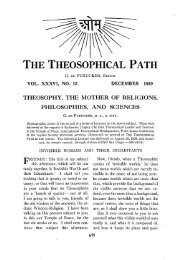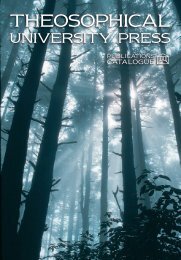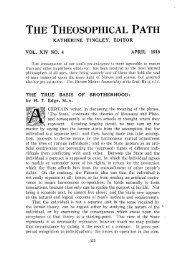To Light a Thousand Lamps - The Theosophical Society
To Light a Thousand Lamps - The Theosophical Society
To Light a Thousand Lamps - The Theosophical Society
Create successful ePaper yourself
Turn your PDF publications into a flip-book with our unique Google optimized e-Paper software.
98 / TO LIGHT A THOUSAND LAMPS<br />
And about the ninth hour Jesus cried with a loud voice,<br />
Ēlī, Ēlī, lāma sabachthānī, that is to say, My God, my God,<br />
why hast thou forsaken me? — 27:46<br />
In the translation the significance of this Hebrew phrase,<br />
inserted in the Greek original, is obscured. In reality, we<br />
have what amounts to two cries: the one of agony, the other<br />
of exaltation. <strong>The</strong> last Hebrew word, sabachthānī does not<br />
mean to forsake or abandon as the King James Version has<br />
it; on the contrary, it means to glorify, to bring peace, to<br />
raise in triumph. Yet the Greek text immediately ‘‘explains’’<br />
it as ‘‘My God, my God, why hast thou forsaken me?’’ —<br />
which actually is a direct translation of the well-known cry<br />
of David in Psalm 22, ’Ēlī, ’Ēlī, lāmāh ‘azabthānī, the final<br />
word indeed meaning ‘‘to forsake.’’<br />
What is the reason for this? It has been suggested that<br />
Matthew and Mark may have intentionally confused the<br />
matter in order to conceal (and yet reveal for those having<br />
eyes to see) what was in fact a Mystery-teaching. In short,<br />
the Greek ‘‘explanation’’ of the Hebrew phrase, quoting<br />
from the psalm, records the anguish felt by the human part<br />
of Jesus when in utter loneliness he had to face the dread<br />
regions of the netherworld and conquer all. Conversely, the<br />
Hebrew cry as preserved in Matthew and Mark was a cry of<br />
the Christos, Jesus triumphant: ‘‘O my God, how thou hast<br />
glorified me, how thou hast brought me out of darkness<br />
into the light!’’*<br />
*<strong>The</strong> author is indebted to G. de Purucker, <strong>The</strong> Esoteric Tradition<br />
1:69‒75; also to Ralston Skinner, <strong>The</strong> Source of Measures, pp. 300‒301,<br />
and ‘‘No Error’’ by JRS (Skinner) in H. P. Blavatsky, Collected Writings<br />
9:276‒9, with corroborative ‘‘Note’’ by HPB on p. 279.













